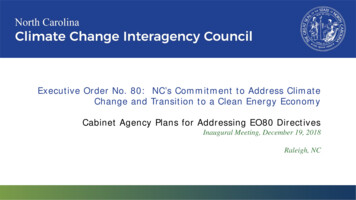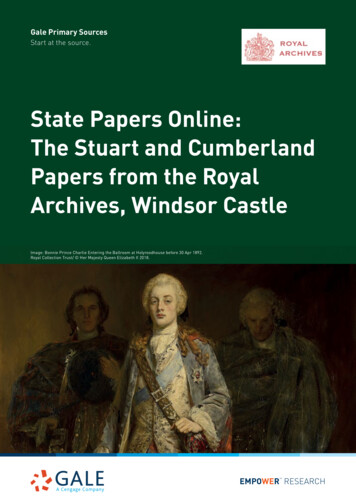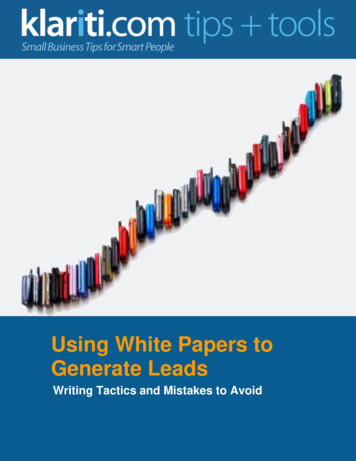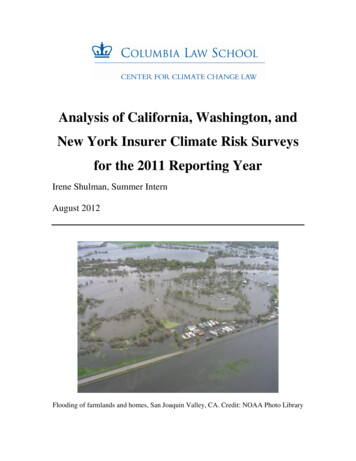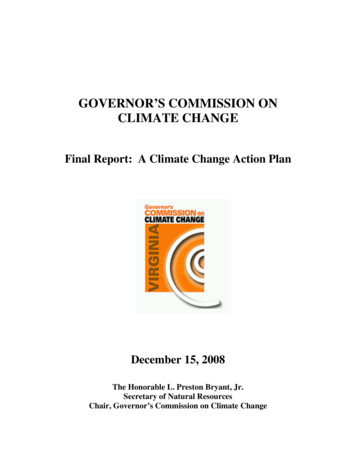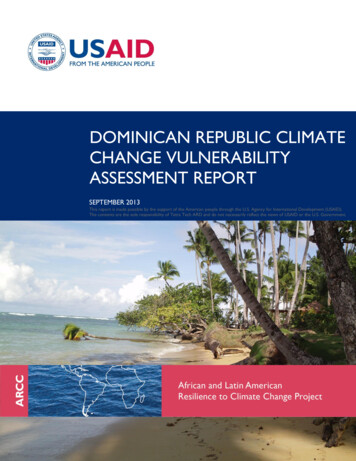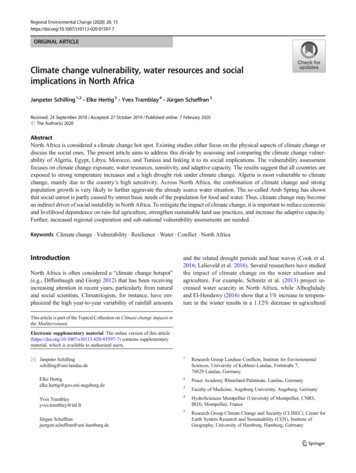
Transcription
Recommended Papers onClimate Change Impact and Its AdaptationTITLE: An integrated approach to assess the vulnerability to erosion in mangroves using GIS models in a tropicalcoastal protected areaAuthors: José Guilherme Moreira Simões Vieira, Joana Salgueiro, Amadeu Mortágua Velho da Maia Soares, UlissesAzeiteiro, Fernando /10.1108/IJCCSM-05-2017-0110/full/htmlABSTRACT: The development of models that allows the evaluation and prediction of erosion processes is an importanttool for the management and planning of coastal systems. Mangrove forests systems are under threat by the impacts oferosion, which is also intensified by human activity (and aggravated in the scenarios of global warming and climate change).The purpose of this paper is to develop a model of geographic information systems (GIS) that can be used for any estuaryarea, but it can also be used for mangroves. This paper uses georeferentiation which is defined as a set of parameters thatbest characterize the mangrove areas: elevation (m); geomorphology; geology; land cover; anthropogenic activities;distance to the coastline (m) and maximum tidal range (m). Three different methods are used to combine the variousvulnerability parameters, namely, DRASTIC index, analytical hierarchy process (AHP) and square root of the geometricmean. The three approaches presented in this work show different types evaluating vulnerability to erosion, highlighting astronger overvaluation of the areas presented with a high vulnerability, through the use of DRASTIC index when comparedwith two other approaches. The use of the AHP shows similarity to the square root of the geometric mean model, but theAHP also presents a higher percentage of vulnerable areas classified as having medium to very high vulnerability. On theother hand, the use of square root of the geometric mean led to a higher percentage of areas classified as having low andvery low vulnerability.1.TITLE: Perceptions of ecosystem services provision performance in the face of climate change amongcommunities in Bobirwa sub-district, BotswanaAuthors: Ephias Mugari, Hillary Masundire, Maitseo Bolaane, Mark 1108/IJCCSM-09-2017-0178/full/htmlABSTRACT: Between 2006 and 2016, local communities in semi-arid Bobirwa sub-district in the Limpopo Basin part ofBotswana had endured notable fluctuations in the delivery of critical ecosystem services. These changes have been coupledwith adverse effects on local people’s livelihood options and well-being. However, a few such studies have focussed on thesemi-arid to arid landscapes. This study therefore aims to provide recent knowledge and evidence of consequences ofenvironmental change on semi-arid arid landscapes and communities. To examine these recent changes in key ecosystemservices, the authors conducted six participatory mapping processes, eight key informant interviews and several rapidscoping appraisals in three study villages. The analyses were centred on changes in seasonal quantities, seasonality,condition of ecosystem service sites, distance to ecosystem service sites and total area providing these services. Driversof change in the delivery of key ecosystem services and the associated adverse impacts on human well-being of theserecent changes in bundles of ecosystem services delivered were also analyzed. Results show that adverse weatherconditions, drought frequency, changes in land-use and/or land-cover together with unsustainable harvesting because ofhuman influx on local resources have intensified in the past decade. There was circumstantial evidence that these drivershave resulted in adverse changes in quantities and seasonality of key ecosystem services such as edible Mopanecaterpillars, natural pastures, wild fruits and cultivated crops. Similarly, distance to, condition and total area of sites providingsome of the key ecosystem services such as firewood and natural pastures changed adversely. These adverse changes inthe key ecosystem services were shown to increasingly threaten local livelihoods and human well-being.2.TITLE: Perceptions of climate change and water availability in the Mediterranean tourist sector: A case studyof the Muga River basin (Girona, Spain)Authors: Maria Torres-Bagur, Anna Ribas Palom, Josep CT: The purpose of this paper is understand these perceptions and identify main problems associated to climatechange in order to design effective mitigation and adaptation strategies to guarantee the sustainability of tourism and naturalresources. The Mediterranean basin is a leading international tourist destination and one that is particularly vulnerable toRecommended Papers on Climate Change Impact and Its Adaptation
2the effects of climate change. Although these effects are largely known, in-depth studies of how they and the associatedrisks are perceived by key tourism stakeholders have not been performed. Interviews were held with 31 hotels, campsitesand rural lodgings in the Muga River basin in north-east Catalonia, in which both owners and managers were asked abouttheir perceptions of climate change, effects and countermeasures. Perceptions of climate change and its effects variedaccording to the type of establishment and location (coast, cities or inland). Significant differences were observed forperceptions of how responsibilities for implementing mitigation and adaptation measures to counter the effects of climatechange, including water shortages, should be shared out between the main agents with an interest in guaranteeing thesustainability of tourism, namely, government bodies, tourist establishments and clients. The predominant opinion, however,was that the bulk of the responsibility should lie with government bodies3.TITLE: Food security outcomes under a changing climate: Impacts of mitigation and adaptation onvulnerability to food insecurityAuthors: Katy J. Richardson, Kirsty H. Lewis, P. Krishna Krishnamurthy, Chris Kent, Andrew J. Wiltshire & Helen s10584-018-2137-yABSTRACT: Climate change is a potential threat to achieving food security, particularly in the most food insecure regions.However, interpreting climate change projections to better understand the potential impacts of a changing climate on foodsecurity outcomes is challenging. This paper addresses this challenge through presenting a framework that enables rapidcountry-level assessment of vulnerability to food insecurity under a range of climate change and adaptation investmentscenarios. The results show that vulnerability to food insecurity is projected to increase under all emissions scenarios, andthe geographic distribution of vulnerability is similar to that of the present-day; parts of sub-Saharan Africa and South Asiaare most severely affected. High levels of adaptation act to off-set these increases; however, only the scenario with thehighest level of mitigation combined with high levels of adaptation shows improvements in vulnerability compared to thepresent-day. The results highlight the dual requirement for mitigation and adaptation to avoid the worst impacts of climatechange and to make gains in tackling food insecurity. The approach is an update to the existing Hunger and ClimateVulnerability Index methodology to enable future projections, and the framework presented allows rapid updates to theresults as and when new information becomes available, such as updated country-level yield data or climate model output.This approach provides a framework for assessing policy-relevant human food security outcomes for use in long-termclimate change and food security planning; the results have been made available on an interactive website for policymakers.4.TITLE: Linking agricultural adaptation strategies, food security and vulnerability: evidence from West AfricaAuthors: Sabine Douxchamps, Mark T. Van Wijk, Silvia Silvestri, Abdoulaye S. Moussa, Carlos Quiros, Ndèye YacineB. Ndour, Saaka Buah, Léopold Somé, Mario Herrero, Patricia Kristjanson, Mathieu Ouedraogo, Philip K. Thornton,Piet Van Asten, Robert Zougmoré & Mariana C. 0113-015-0838-6ABSTRACT: Adaptation strategies to reduce smallholder farmers’ vulnerability to climate variability and seasonality areneeded given the frequency of extreme weather events predicted to increase during the next decades in sub-Saharan Africa,particularly in West Africa. We explored the linkages between selected agricultural adaptation strategies (crop diversity, soiland water conservation, trees on farm, small ruminants, improved crop varieties, fertilizers), food security, farm householdcharacteristics and farm productivity in three contrasting agro-ecological sites in West Africa (Burkina Faso, Ghana andSenegal). Differences in land area per capita and land productivity largely explained the variation in food security acrosssites. Based on land size and market orientation, four household types were distinguished (subsistence, diversified,extensive, intensified), with contrasting levels of food security and agricultural adaptation strategies. Income increasedsteadily with land size, and both income and land productivity increased with degree of market orientation. The adoption ofagricultural adaptation strategies was widespread, although the intensity of practice varied across household types.Adaptation strategies improve the food security status of some households, but not all. Some strategies had a significantpositive impact on land productivity, while others reduced vulnerability resulting in a more stable cash flow throughout theyear. Our results show that for different household types, different adaptation strategies may be ‘climate-smart’. Thetypology developed in this study gives a good entry point to analyse which practices should be targeted to which type ofsmallholder farmers, and quantifies the effect of adaptation options on household food security. Subsequently, it will becrucial to empower farmers to access, test and modify these adaptation options, if they were to achieve higher levels offood security.Recommended Papers on Climate Change Impact and Its Adaptation
35.TITLE: The economic and food security implications of climate change in maliAuthors: T. A. Butt, B. A. McCarl, J. Angerer, P. T. Dyke & J. W. 584-005-6014-0ABSTRACT: The study focuses on economic and food security implications of projected climate change on Malianagriculture sector. Climate change projections made by two global circulation models are considered. The analysis focuseson the effects on crops, forages, and livestock and the resultant effects on sectoral economics and risk of hunger in Mali.Results show that under climate change, crop yield changes are in the range of minus 17% to plus 6% at national level.Simultaneously, forage yields fall by 5 to 36% and livestock animal weights are reduced by 14 to 16%. The resultanteconomic losses range between 70 to 142 million, with producers gaining, but consumers losing. The percentage ofpopulation found to be at risk of hunger rises from a current estimate of 34% to an after climate change level of 64% to 72%.A number of policy and land management strategies can be employed to mitigate the effects of climate change. In particular,we investigate the development of heat resistant cultivars, the adoption of existing improved cultivars, migration of croppingpattern, and expansion of cropland finding that they effectively reduce climate change impacts lowering the risk of hungerto as low as 28%.6.TITLE: From climate-smart agriculture to climate-smart landscapesAuthors: Sara J Scherr, Seth Shames & Rachel 2048-7010-1-12ABSTRACT: For agricultural systems to achieve climate-smart objectives, including improved food security and rurallivelihoods as well as climate change adaptation and mitigation, they often need to be taken a landscape approach; theymust become ‘climate-smart landscapes. Climate-smart landscapes operate on the principles of integrated landscapemanagement, while explicitly incorporating adaptation and mitigation into their management objectives. Results: Anassessment of climate change dynamics related to agriculture suggests that three key features characterize a climate-smartlandscape: climate-smart practices at the field and farm scale; diversity of land use across the landscape to provideresilience; and management of land use interactions at landscape scale to achieve social, economic and ecological impacts.To implement climate-smart agricultural landscapes with these features (that is, to successfully promote and sustain themover time, in the context of dynamic economic, social, ecological and climate conditions) requires several institutionalmechanisms: multi-stakeholder planning, supportive landscape governance and resource tenure, spatially-targetedinvestment in the landscape that supports climate-smart objectives, and tracking change to determine if social and climategoals are being met at different scales. Examples of climate-smart landscape initiatives in Madagascar’s Highlands, theAfrican Sahel and Australian Wet Tropics illustrate the application of these elements in contrasting contexts. To achieveclimate-smart landscape initiatives widely and at scale will require strengthened technical capacities, institutions and politicalsupport for multi-stakeholder planning, governance, spatial targeting of investments and multi-objective impact monitoring.7.TITLE: Water management: Current and future challenges and research directionsAuhors: William J. Cosgrove Daniel P. OMHES1ABSTRACT: Water distinguishes our planet compared to all the others we know about. While the global supply of availablefreshwater is more than adequate to meet all current and foreseeable water demands, its spatial and temporal distributionsare not. There are many regions where our freshwater resources are inadequate to meet domestic, economic developmentand environmental needs. In such regions, the lack of adequate clean water to meet human drinking water and sanitationneeds is indeed a constraint on human health and productivity and hence on economic development as well as on themaintenance of a clean environment and healthy ecosystems. All of us involved in research must find ways to remove theseconstraints. We face multiple challenges in doing that, especially given a changing and uncertain future climate, and arapidly growing population that is driving increased social and economic development, globalization, and urbanization. Howbest to meet these challenges requires research in all aspects of water management. Since 1965, the journal WaterResources Research has played an important role in reporting and disseminating current research related to managing thequantity and quality and cost of this resource. This paper identifies the issues facing water managers today and futureresearch needed to better inform those who strive to create a more sustainable and desirable future.Recommended Papers on Climate Change Impact and Its Adaptation
48.TITLE: Understanding and managing the food-energy-water nexus – opportunities for water resourcesresearchAuthors: XimingCai, KevinWallington, MajidShafiee-Jood, Landon le/abs/pii/S0309170817304475ABSTRACT: Studies on the food, energy, and water (FEW) nexus lay a shared foundation for researchers, policy makers,practitioners, and stakeholders to understand and manage linked production, utilization, and security of FEW systems. TheFEW nexus paradigm provides the water community specific channels to move forward in interdisciplinary research whereintegrated water resources management (IWRM) has fallen short. Here, we help water researchers identify, articulate, utilize,and extend our disciplinary strengths within the broader FEW communities, while informing scientists in the food and energydomains about our unique skillset. This paper explores the relevance of existing and ongoing scholarship within the watercommunity, as well as current research needs, for understanding FEW processes and systems and implementing FEWsolutions through innovations in technologies, infrastructures, and policies. Following the historical efforts in IWRM,hydrologists, water resources engineers, economists, and policy analysts are provided opportunities for interdisciplinarystudies among themselves and in collaboration with energy and food communities, united by a common path to achievesustainability development goals.9.TITLE: State of the art for genetic algorithms and beyond in water resources planning and managementAuthors: John Nicklow, Patrick Reed, Dragan Savic; Tibebe Dessalegne, Laura Harrell, Amy Chan-Hilton, MohammadKaramouz, Barbara Minsker, Avi Ostfeld, Abhishek Singh, and Emily SCE)WR.1943-5452.0000053ABSTRACT: During the last two decades, the water resources planning and management profession has seen a dramaticincrease in the development and application of various types of evolutionary algorithms (EAs). This observation is especiallytrue for application of genetic algorithms, arguably the most popular of the several types of EAs. Generally speaking, EAsrepeatedly prove to be flexible and powerful tools in solving an array of complex water resources problems. This paperprovides a comprehensive review of state-of-the-art methods and their applications in the field of water resources planningand management. A primary goal in this ASCE Task Committee effort is to identify in an organized fashion some of theseminal contributions of EAs in the areas of water distribution systems, urban drainage and sewer systems, water supplyand wastewater treatment, hydrologic and fluvial modeling, groundwater systems, and parameter identification. The paperalso identifies major challenges and opportunities for the future, including a call to address larger-scale problems that arewrought with uncertainty and an expanded need for cross fertilization and collaboration among our field’s subdisciplines.Evolutionary computation will continue to evolve in the future as we encounter increased problem complexities anduncertainty and as the societal pressure for more innovative and efficient solutions rises.10. TITLE: Unsustainability Syndrome—From Meteorological to Agricultural Drought in Arid and Semi-AridRegionsAuthors:Ali Torabi Haghighi , Nizar Abou Zaki , Pekka M. Rossi , Roohollah Noori , Ali Akbar Hekmatzadeh , HosseinSaremi and Bjørn RACT: Water is the most important resource for sustainable agriculture in arid and semi-arid regions, whereagriculture is the mainstay for rural societies. By relating the water usage to renewable water resources, we define threestages from sustainable to unsustainable water resources: (1) sustainable, where water use is matched by renewable watercapacity, ensuring sustainable water resources; (2) transitional, where water use occasionally exceeds renewable watercapacity; and (3) unsustainable, with lack of water resources for agriculture, society, and the environment. Using availabledrought indicators (standardized precipitation index (SPI) and streamflow drought index (SDI)) and two new indices foragricultural drought (overall agricultural drought index (OADI) and agricultural drought index (ADI)), we evaluated thesestages using the example of Fars province in southern Iran in the period 1977–2016. A hyper-arid climate prevailed for anaverage of 32% of the province’s spatio-temporal coverage during the study period. The area increased significantly from30.6% in the first decade (1977–1986) to 44.4% in the last (2006–2015). The spatiotemporal distribution of meteorologicaldrought showed no significant negative trends in annual precipitation during 1977–2016, but the occurrence of hydrologicaldroughts increased significantly in the period 1997–2016. The expansion of irrigated area, with more than 60% of rainfedagriculture replaced by irrigated agriculture (especially between 1997 and 2006), exerted substantial pressure on surfacewater and groundwater resources. Together, climate change, reduced river flow, and significant declines in groundwaterlevel in major aquifers led to unsustainable use of water resources, a considerable reduction in irrigated area, andunsustainability in agricultural production in the period 2006–2015. Analysis of causes and effects of meteorological,Recommended Papers on Climate Change Impact and Its Adaptation
5hydrological, and agricultural drought in the area identified three clear stages: before 1997 being sustainable, 1997–2006being transitional, and after 2006 being unsustainable.11. TITLE: Revisiting Telemetry in Pakistan’s Indus Basin Irrigation SystemAuthors: Muhammad Tousif Bhatti, Arif A. Anwar and Muhammad Azeem Ali ACT: The Indus Basin Irrigation System (IBIS) lacks a system for measuring canal inflows, storages, and outflowsthat is trusted by all parties, transparent, and accessible. An earlier attempt for telemetering flows in the IBIS did not deliver.There is now renewed interest in revisiting telemetry in Pakistan’s IBIS at both national and provincial scales. Theseinvestments are typically approached with an emphasis on hardware procurement contracts. This paper describes theexperience from field installations of flow measurement instruments and communication technology to make the case thatcanal flows can be measured at high frequency and displayed remotely to the stakeholders with minimal loss of data andlag time between measurement and display. The authors advocate rolling out the telemetry system across IBIS as a dataas a service (DaaS) contract rather than as a hardware procurement contract. This research addresses a key issue of howsuch a DaaS contract can assure data quality, which is often a concern with such contracts. The research findings informfuture telemetry investment decisions in large-scale irrigation systems, particularly the IBIS.12. TITLE: Increasing compound events of extreme hot and dry days during growing seasons of wheat and maizein ChinaAuthors: You Lu, Hongchang Hu, Chao Li & Fuqiang 15-yABSTRACT: Compound events of climate extremes such as extremely high temperature and low precipitation during cropgrowing seasons can greatly affect agricultural production and food security. No study has investigated how CompoundExtreme Hot and Dry days (CEHD days) during crop-growing seasons have changed or will change in response to climatewarming. Based on observations, we fnd upward trends in CEHD days during wheat and maize growing seasons in Chinain the historical period 1980–2015. These trends are remarkably different during wheat and maize growing seasons, pointingto the need for targeted analysis focusing on crop-specific growing seasons. Projections of future temperature andprecipitation from the Coordinated Regional Climate Downscaling Experiment show that upward trends will continue intofuture. On average over China, the frequencies of CEHD days during wheat and maize growing seasons are projected toincrease respectively by 168% and 162% in 2036–2050 relatively to 1980–2015 under the RCP8.5 emissions scenario. Theprojected increases may have serious implications for China’s food production, adding to the need for resilience planningto limit the impacts of growing season CEHD days.13. TITLE: Projected climate change impacts on future streamflow of the Yarlung Tsangpo Brahmaputra RiverAuthors: Ran Xua, Hongchang Hua, Fuqiang Tiana, Chao Li, Mohd Yawar Ali pii/S092181811830506XABSTRACT: The Yarlung Tsangpo-Brahmaputra River (YBR) originating from the Tibetan Plateau (TP), is an importantwater source for many domestic and agricultural practices in countries including China, India, Bhutan and Bangladesh. Todate, only a few studies have investigated the impacts of climate change on water resources in this river basin with dispersedresults. In this study, we provide a comprehensive and updated assessment of the impacts of climate change on YBRstreamflow by integrating a physically based hydrological model, regional climate integrations from CORDEX (CoordinatedRegional Climate Downscaling Experiment), different bias correction methods, and Bayesian model averaging method. Wefind that (i) bias correction is able to reduce systematic biases in regional climate integrations and thus benefits hydrologicalprojections over YBR Basin; (ii) Bayesian model averaging, which optimally combines individual hydrological simulationsobtained from different bias correction methods, tends to provide hydrological time series superior over individual ones. Weshow that by the year 2035, the annual mean streamflow is projected to change respectively by 6.8%, 0.4%, and 4.1%under RCP4.5 relative to the historical period (1980–2001) at the Bahadurabad in Bangladesh, the upper Brahmaputraoutlet, and Nuxia in China. Under RCP8.5, these percentage changes will substantially increase to 12.9%, 13.1%, and19.9%. Therefore, the change rate of streamflow shows strong spatial variability along the YBR from downstream toupstream. The increasing rate of streamflow shows an augmented trend from downstream to upstream under RCP8.5compared to an attenuated pattern under RCP4.5.Recommended Papers on Climate Change Impact and Its Adaptation
614. TITLE: Assessment of Climate Change Impacts on Reference Evapotranspiration and Simulation of DailyWeather Data Using SIMETAWAuthors: Meisam Ebrahimpour; Nozar Ghahreman; and Morteza )IR.1943-4774.0000669ABSTRACT: In this study, a SIMulation of EvapoTranspiration of Applied Water (SIMETAW) model was evaluated usingmonthly climatic data of four stations in Iran, namely Bushehr, Tabriz, Zahedan, and Mashhad, to investigate the effects ofclimate change on reference evapotranspiration (ETo). SIMETAW generates daily weather data from monthly valuesapplicable in climate change studies. HadCM3 (Hadley Centre Coupled Model ver.3) outputs were statistically downscaledto project future variables. Maximum, minimum, and dew point temperature, precipitation, and wind speed were downscaledunder two emission scenarios (A2 and B2) and two future periods (2020 2050 and 2050–2080) to simulate ETo. CalculatedETo values were compared with those simulated by SIMETAW in the base period (1961–2000). Results showed that, exceptfor daily wind speed, the model accurately generated daily temperature variables and monthly precipitation. Furthermore,ETo is expected to increase in most months. Values of ETo at Bushehr Station are projected to increase from 164.7 to181.2 mm month in 2050–2080, under the B2 scenario. The corresponding values are 125.4 to 137.5, 182.7 to 197.5, and118.3 to 128.8 mm month for Tabriz, Zahedan, and Mashhad, respectively.15. TITLE: Comparison of three multi‑site models in stochastic reconstruction of winter daily rainfall over IranAuthors: Mahdi Ghamghami,· Nozar Ghahreman,· Hossein Olya, · Tahereh 0808-019-00599-7ABSTRACT: Spatiotemporal modeling of daily rainfall may establish the spatial relationships between diferent stationswhich is important issue in hydro-climatology and has been addressed by various studies. The aim of this study is tocompare three multi-site models, i.e. hidden Markov model (HMM), non-homogeneous hidden Markov model (NHMM), andK-nearest neighbor model (KNN) in stochastic generation of rainfall data over a network consisting of 130 synoptic stationsacross Iran using 20-year (1991–2010) daily dataset. Regarding the NHMM, the hidden layer parameters were consideredtime dependent, such that a layer including predictors was added to HMM. General circulation model (GCM) outputs couldbe selected as the elements of this layer or predictors. A principle component analysis (PCA) was implemented on fourstandardized variables of HADGEM2 model (pressure, geo-potential height, temperature, and specifc humidity) for historicalperiod on 29 grids across Iran. Accordingly, pressure variable has been selected as a predictor layer in the NHMM accordingto Bayesian Information criteria (BIC). Results showed that the NHMM has a signifcant lower BIC compared to the HMM,which confrms the time-dependence assumption of Markov transition probabilities. In stochastic generation process byNHMM and KNN models, diferent criteria such as seasonal mean and variance, empirical distribution of daily precipitationdata in winter, probabilities of wet and dry spells in various sequences and spatial dependency have been compared.According to the results, the NHMM had a signifcantly better performance compared to KNN model. Nevertheless, no modelwas able to precisely generate rainfall based on all the evaluation criteria. Log-odds ratio as the spatial correlation criterionillustrated that both NHMM and KNN have promising results in reconstructing spatial relationships. Therefore, both modelscould be considered as multi-site approaches with a good skill in keeping spatiotemporally changing parameters. Thefndings of this study may improve the seasonal predictability of rainfall characteristics across the country. Recommended Papers on Climate Change Impact and Its Adaptation
1. TITLE: Perceptions of ecosystem services provision performance in the face of climate change among communities in Bobirwa sub-district, Botswana Authors: Ephias Mugari . country-level assessment of vulnerability to food insecurity under a range of climate change and adaptation investment . management, while explicitly incorporating .

